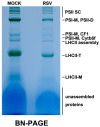Characterization of Proteins Involved in Chloroplast Targeting Disturbed by Rice Stripe Virus by Novel Protoplast⁻Chloroplast Proteomics
- PMID: 30634635
- PMCID: PMC6358847
- DOI: 10.3390/ijms20020253
Characterization of Proteins Involved in Chloroplast Targeting Disturbed by Rice Stripe Virus by Novel Protoplast⁻Chloroplast Proteomics
Abstract
Rice stripe virus (RSV) is one of the most devastating viral pathogens in rice and can also cause the general chlorosis symptom in Nicotiana benthamiana plants. The chloroplast changes associated with chlorosis symptom suggest that RSV interrupts normal chloroplast functions. Although the change of proteins of the whole cell or inside the chloroplast in response to RSV infection have been revealed by proteomics, the mechanisms resulted in chloroplast-related symptoms and the crucial factors remain to be elucidated. RSV infection caused the malformation of chloroplast structure and a global reduction of chloroplast membrane protein complexes in N. benthamiana plants. Here, both the protoplast proteome and the chloroplast proteome were acquired simultaneously upon RSV infection, and the proteins in each fraction were analyzed. In the protoplasts, 1128 proteins were identified, among which 494 proteins presented significant changes during RSV; meanwhile, 659 proteins were identified from the chloroplasts, and 279 of these chloroplast proteins presented significant change. According to the label-free LC⁻MS/MS data, 66 nucleus-encoded chloroplast-related proteins (ChRPs), which only reduced in chloroplast but not in the whole protoplast, were identified, indicating that these nuclear-encoded ChRPswere not transported to chloroplasts during RSV infection. Gene ontology (GO) enrichment analysis confirmed that RSV infection changed the biological process of protein targeting to chloroplast, where 3 crucial ChRPs (K4CSN4, K4CR23, and K4BXN9) were involved in the regulation of protein targeting into chloroplast. In addition to these 3 proteins, 41 among the 63 candidate proteins were characterized to have chloroplast transit peptides. These results indicated that RSV infection changed the biological process of protein targeting into chloroplast and the location of ChRPs through crucial protein factors, which illuminated a new layer of RSV⁻host interaction that might contribute to the symptom development.
Keywords: chloroplast proteomics; chloroplast targeting; nuclear/nucleus-encoded chloroplast-related protein; plant–virus interaction; rice stripe virus.
Conflict of interest statement
The authors declare no conflict of interest.
Figures



Similar articles
-
Identification and regulation of host genes related to Rice stripe virus symptom production.New Phytol. 2016 Feb;209(3):1106-19. doi: 10.1111/nph.13699. Epub 2015 Oct 21. New Phytol. 2016. PMID: 26487490
-
NS3 Protein from Rice stripe virus affects the expression of endogenous genes in Nicotiana benthamiana.Virol J. 2018 Jun 25;15(1):105. doi: 10.1186/s12985-018-1014-7. Virol J. 2018. PMID: 29940994 Free PMC article.
-
Interaction between Rice stripe virus disease-specific protein and host PsbP enhances virus symptoms.Mol Plant. 2014 Apr;7(4):691-708. doi: 10.1093/mp/sst158. Epub 2013 Nov 8. Mol Plant. 2014. PMID: 24214893
-
Ferredoxin 1 is downregulated by the accumulation of abscisic acid in an ABI5-dependent manner to facilitate rice stripe virus infection in Nicotiana benthamiana and rice.Plant J. 2021 Aug;107(4):1183-1197. doi: 10.1111/tpj.15377. Epub 2021 Jul 10. Plant J. 2021. PMID: 34153146
-
Chloroplast proteomics: potentials and challenges.J Exp Bot. 2004 May;55(400):1213-20. doi: 10.1093/jxb/erh104. Epub 2004 Mar 12. J Exp Bot. 2004. PMID: 15020636 Review.
Cited by
-
Cell Fractionation and the Identification of Host Proteins Involved in Plant-Virus Interactions.Pathogens. 2024 Jan 5;13(1):53. doi: 10.3390/pathogens13010053. Pathogens. 2024. PMID: 38251360 Free PMC article. Review.
-
An Efficient and Economical Protocol for Isolating, Purifying and PEG-Mediated Transient Gene Expression of Chinese Kale Hypocotyl Protoplasts.Plants (Basel). 2019 Sep 28;8(10):385. doi: 10.3390/plants8100385. Plants (Basel). 2019. PMID: 31569422 Free PMC article.
-
The Bunyavirales: The Plant-Infecting Counterparts.Viruses. 2021 May 6;13(5):842. doi: 10.3390/v13050842. Viruses. 2021. PMID: 34066457 Free PMC article. Review.
-
Turnip mosaic virus P1 suppresses JA biosynthesis by degrading cpSRP54 that delivers AOCs onto the thylakoid membrane to facilitate viral infection.PLoS Pathog. 2021 Dec 1;17(12):e1010108. doi: 10.1371/journal.ppat.1010108. eCollection 2021 Dec. PLoS Pathog. 2021. PMID: 34852025 Free PMC article.
-
Downregulation of Light-Harvesting Complex II Induces ROS-Mediated Defense Against Turnip Mosaic Virus Infection in Nicotiana benthamiana.Front Microbiol. 2021 Jul 5;12:690988. doi: 10.3389/fmicb.2021.690988. eCollection 2021. Front Microbiol. 2021. PMID: 34290685 Free PMC article.
References
-
- Yeam I. Current advances and prospectus of viral resistance in horticultural crops. Hortic. Environ. Biotechnol. 2016;57:113–122. doi: 10.1007/s13580-016-0105-x. - DOI
MeSH terms
Substances
Grants and funding
LinkOut - more resources
Full Text Sources

